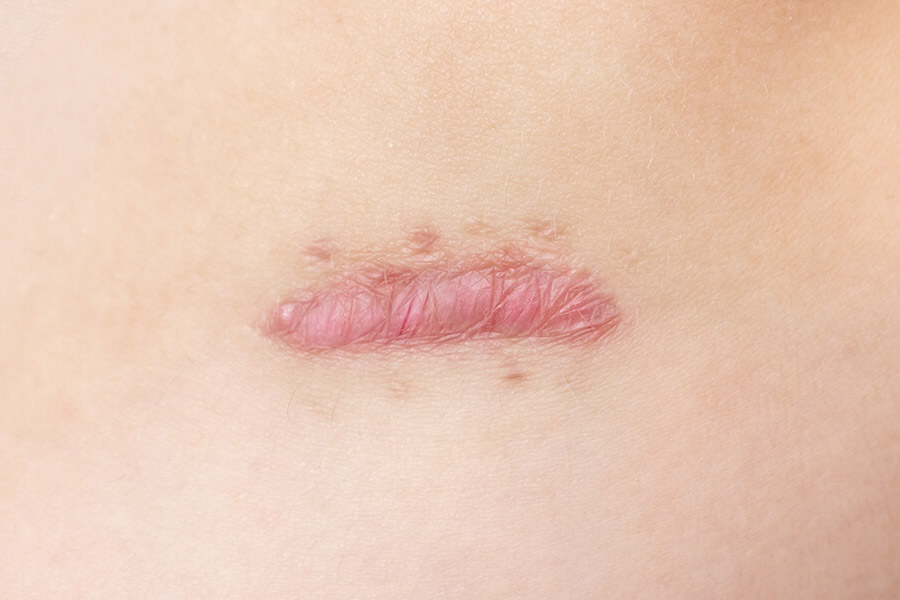- Find a Doctor
- Services & Specialties
-
-
Services & Specialties
-
-
-
-
- Find a Location
- News & Resources
-
-
News & Resources
- Latest News
- Learn More About Our Surgery Centers
- Why Proliance Surgeons?
- Meet Our Leadership
- Meet Our Board
- 24/7 Care Info
- Contact Us Today
- Pay My Bill
- Career Opportunities
- Mission, Vision, Values
- Phreesia FAQ
- Insurance Plans
- Medical Records
- Balance Billing Protection Act
- PELTO Health Partners
- Revenue Cycle Credit Resolution
- Proliance Surgeons Foundation
- Mental Health Resources
-
-
-
-
- Pricing
Scar Revision
Scar revision is a type of treatment that can fall within cosmetic or medically necessary. There are a range of scar revision techniques available to patients, from topical treatments to surgery that can help remove cesarean birth scars, burns, and acne.

What is Scar Revision?
Treatments to remove or reduce scarring, and scar revision, can include different types of medical techniques. The overall goal of scar revision is to help the scar more closely match the color and texture of the surrounding skin, but won’t completely eliminate it.
Scar removal services are usually pursued for cosmetic reasons, but if a scar is painful or makes it difficult for the body to function, impeding movement for example, then it is considered a medical treatment.
Types of Scars
Scars can be of different types, such as thick and raised (hypertrophic scars) or lumpy and very large (keloid scars). Other scar types can be flat, beneath the surface of the skin, or discolored. For scar revision, the type of scar, its location, and its cause are important factors in determining the best type of scar revision for your case.
Some common causes of scarring that can lead to wanting scar revision include:
- Piercings
- Skin infections
- Trauma
- Cleft lip
- C-section surgery
- Burns, from accidents or radiation therapy
- Acne
Types of Scar Treatment: Scar Revision Techniques
Depending on the type of scar and its location, there are several types of scar revision treatments that can be recommended:
Topical Scar Treatment
A topical scar treatment is applied by the provider and is most effective as a wound heals or for mild and newly formed scars. They can include:
- Polyurethane dressing: A self-adhesive bandage or pad that can reduce the scar’s hardness and size.
- Pressure therapy: A bandage or wrap that applies pressure to the wound as it heals or to a newly formed scar to either reduce the appearance of a raised scar or to help prevent it entirely.
- Silicone gel: A flexible sheet coated with silicone gel is applied to the wound or scar. It can help relieve redness, itching, and irritation caused by the scar or prevent a raised scar from forming.
The topical treatment usually needs to be done 12 to 24 hours each day, sometimes for months at a time.
Injectable Treatments
Injectables are most effective for keloid scars (lumpy and large scars) and raised ones. They can reduce the size and minimize the pain, irritation, and itching of scars. These injections are often needed multiple times:
- Corticosteroid injections: These reduce the formation of collagen in the skin, which can minimize the size, texture, and scar’s appearance.
- Cryotherapy: Liquid nitrogen or argon gas is used to freeze the scar tissue, causing it to die. Often used for smaller-sized scars.
- 5-FU or bleomycin injections: These are drugs for certain types of cancer as they stop cell growth, but can also be used to prevent scars.
Skin Resurfacing
Skin resurfacing treatment removes the top layers of the skin to show smoother, undamaged skin, which improves the color and texture of a scar:
- Dermabrasion: By sanding away at a scar with a brush or rough pad, the top layers of skin are removed.
- Dermaplaning: Using a special razor, a healthcare provider shaves away the upper layers of skin. This treatment is usually used to improve the appearance of acne scars.
- Chemical peel: A healthcare provider applies a type of acid to the skin. This treatment is usually for mild scars on the face.
- Skin bleaching: Substances are applied that can lighten the skin, reducing the appearance of scars.
- Light or laser therapy: Using light or heat, the treatment triggers skin cell turnover to reduce irritation and help the scar return to a normal skin color.
- Microneedling: A healthcare provider uses a device to create microscopic punctures in the skin, encouraging the scar to remodel itself which improves its appearance.
Scar Surgery
For large and severe scars, especially ones that impede movement or cause pain, surgery may be needed. There are two most common scar revision surgery types:
- Z-plasty: The surgeon cuts the scarred skin into a “Z” formation, giving the area of the skin more movement after healing.
- W-plasty: The surgeon cuts the scarred skin in a “W” formation, giving the area more movement once it heals.
In some cases, a skin graft is needed if there isn’t enough healthy skin around the wound for it to close. Using skin from another area of the body, the surgeon can provide healthier skin tissue. This treatment is most common for severe burn victims


